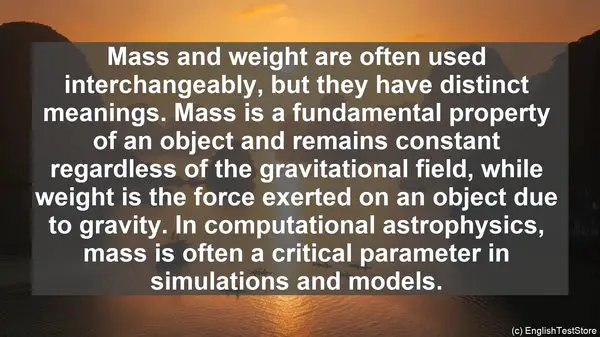Introduction: The Importance of Clear Communication
Welcome to another exciting lesson on computational astrophysics. As researchers and students in this field, we often come across various terms that can be quite confusing. In this lesson, we’ll delve into the top 10 words that frequently cause confusion. By the end, you’ll have a clear understanding of these terms, enabling you to communicate your ideas more effectively.
1. Precision vs. Accuracy
The terms ‘precision’ and ‘accuracy’ are often used interchangeably, but they have distinct meanings. Precision refers to the level of detail or fineness in a measurement, while accuracy refers to how close a measurement is to the true or accepted value. In computational astrophysics, both precision and accuracy are crucial, as they impact the reliability of our results.
2. Algorithm vs. Code
While ‘algorithm’ and ‘code’ are related, they refer to different aspects. An algorithm is a step-by-step procedure or set of rules for solving a problem, while code is the implementation of that algorithm in a programming language. Understanding the distinction is essential when discussing the design, efficiency, or optimization of a computational method.
3. Simulation vs. Modeling
In computational astrophysics, simulations and modeling are commonly used to study complex phenomena. A simulation involves recreating a real-world process using computational methods, while modeling focuses on developing mathematical or conceptual frameworks to understand a system. Both approaches have their merits and are often used in conjunction.
4. Convergence vs. Divergence
Convergence and divergence are terms used when analyzing numerical methods. Convergence refers to the property of a method to approach a specific solution as the computational resources increase, while divergence indicates that the method fails to converge or produces unstable results. Assessing convergence is vital to ensure the accuracy of our computations.
5. Singular vs. Plural
In scientific writing, it’s essential to use the correct form of nouns. Singular nouns refer to a single entity, while plural nouns indicate multiple entities. Using the appropriate form not only ensures grammatical correctness but also avoids confusion when referring to quantities or objects in a research context.

6. Parameter vs. Variable
Parameters and variables are fundamental in computational astrophysics. A parameter is a fixed value that influences the behavior of a system or model, while a variable can change. Distinguishing between the two is crucial, as parameters often represent physical quantities, while variables are used to denote changing conditions or properties.
7. Correlation vs. Causation
When analyzing data, it’s important to understand the difference between correlation and causation. Correlation indicates a statistical relationship between two variables, while causation implies a cause-and-effect relationship. While correlation can provide insights, establishing causation requires additional evidence or experimental validation.

8. Absolute vs. Relative
Absolute and relative are terms used to describe quantities or values. Absolute refers to a value without considering other factors, while relative takes into account a reference or comparison. In computational astrophysics, understanding whether a value is absolute or relative is crucial for accurate interpretations and analyses.
9. Mass vs. Weight
Mass and weight are often used interchangeably, but they have distinct meanings. Mass is a fundamental property of an object and remains constant regardless of the gravitational field, while weight is the force exerted on an object due to gravity. In computational astrophysics, mass is often a critical parameter in simulations and models.
10. Bias vs. Random Error
Bias and random error are sources of uncertainty in measurements or data. Bias refers to a consistent deviation from the true value, while random error is unpredictable and fluctuates. Identifying and quantifying these errors is essential for assessing the reliability and validity of our computational results.
